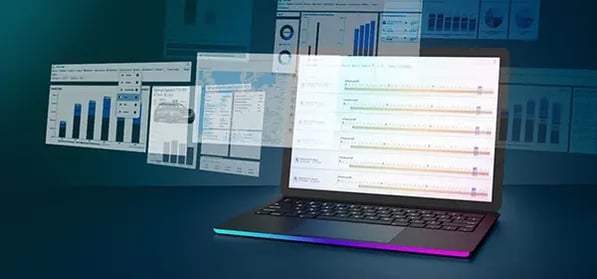Prices under Control
IN FOCUS
Do Automotive Suppliers Have Their Prices under Control?
5 questions that decide about profit

- Resources
- Publications
- Prices under Control
Executive Summary
- Price management has a lot of complexity and an enormous importance for sales and profit achievement.
- Neither Excel nor CRM can meet the requirements of automotive suppliers for professional price management.
- The results of the right digitalization are:
- Consistency in one system over the entire lifecycle: from the creation of prices in the acquisition phase to modifications through change and claim management
- Real-time sales planning with up-to-date prices
- Focus on profits in pricing
- Transparent quotation processes
- Price and order management that is automated and therefore error-free and efficient
- All requirements of automotive suppliers are successfully implemented with the new "PRICE" module of the leading industry standard Digital Automotive by automotive suppliers for automotive suppliers.
INTRO
"PRICES ARE ALL IN THE SAP - OR ARE THEY?"
How do prices actually arise and how do they evolve over the lifecycle before they become the basis for invoicing?
To answer the introductory question directly: Hopefully, you have all prices for your series projects based on price orders in your ERP system. Strategic projects, acquisition and development projects probably can not be found there. And also the price development for the future (see chapter 2) is rather rarely found in the ERP systems. The crucial question: where are the prices of automotive suppliers in reality? You guessed it - in decentralized, non-standardized Excel files on the hard drives of the sales staff.

"As price management is the key factor determining sales and profits, it must be a top priority for automotive suppliers."
Erik Reiter
25 years Automotive Supplier-Management (Sales -> CEO); Sales Consultant for Strategy and Processes; Co-Founder Digital Automotive
Every automotive manager is surely aware of the importance of prices for profitability. However, the complexity and variety in which prices are managed is often underestimated. It is time to professionalize this process across the organization, in a digital environment designed for automotive suppliers.
In production, there are detailed process descriptions, standardizations, automations, quality measures and controls to ensure that work is done perfectly. In price management, there is a reliance on the individual talent of sales people with their hundreds of self-made Mega-Excel-spreadsheets.
A flood of price modifications from technical changes and claim management is managed in Excel - without any transparency or traceability. Is one not aware of the influence of calculation and transfer errors and the massive inefficiencies in this process or does one live with this situation because there has been no really useful alternative so far?
Every automotive supplier should take a critical look at the following questions and answer whether the current way of working is up to date or should be replaced by a digital solution that is deeply integrated into the processes.
QUESTION 1
How are your Prices created?
Cost calculation scheme and customer CBD: Is there a price bottom line?
As astonishing as it sounds, customer CBD's have an impact on the quality and level of your prices. Some OEMs have managed to convince sales staff that only the customer cost break down (CBD) is relevant, with the result that offers are made detached from any price bottom line.
Professional price management always compares the prices to be offered with the costs. Good systems offer the flexibility to use different schemes depending on the customer or product.
Calculation bases, factors and surcharges: Is the calculation really correct?
Material costs and lead times are mostly well standardized among suppliers. The first hurdle starts with the factors and surcharges.
Anyone who takes the effort to analyze the existing Excel calculations in detail will quickly realize that the factors and surcharges used for cost or price calculation correspond to some historical values that have long since become far removed from reality. A continuously updated table for the factors and surcharges to be used for calculation is essential in order not to be surprised with projects in the series that generate losses.
Pricing strategies: Do they succeed in being implemented across the organization?
For the pricing itself, the question arises as to whether it is formed according to simple cost-plus mechanisms, whether it is created on the basis of customer-driven targets, or whether active pricing takes place that takes into account take-rates as well as modern approaches to "value-based pricing".
There are certainly individual sales people at every automotive supplier who implement these processes perfectly. However, it is crucial to work with a standard across the board that forms the basis for pricing.
Approvals: Is there a standard that leads to reliable decisions?
In the acquisition phase, in which the prices become part of the contract, a transparent process must be used to ensure that the prices to be submitted are in line with the business plan and are approved. The nomination by the customer based on this is the starting point of the price history, from which the prices are to be updated without gaps up to EOP on the basis of the subsequent changes.
QUESTION 2
How do your Prices change?
Prices change continuously. And this starts from the day of the order.
There are 4 main reasons for price adjustments: Lifetime reductions (LTAs/ LTCs) and amortizations of investments are usually already agreed with the customer in the acquisition phase. After the order has been placed, price adjustments are usually made as part of change and claim management.
These 4 reasons and their challenges are briefly described below:
(1) Lifetime reductions - do you give only what you really have to?
The first changes in prices are usually already contractually agreed when the order is placed. These price reductions, so-called lifetime agreements (LTA's/ LTC's) are the basis for future invoicing and multi-year planning (sales planning).
Price components that are contractually excluded from a reduction are important. Examples are packaging or OEM-nominated purchased parts. Here it is crucial to have a stringent process that takes these non-reductions into account so that in the end not too much reduction is given.
(2) Changes - is the process stringent until the price order is received?
The largest area from which prices continuously change are technical change requests from the customer that lead to price adjustments. Depending on the product group, these can mean more than 1000 changes per project.
The more changes there are, the more important this process is for profitability, of course. But even for products with few changes, consistent change management usually determines profit or loss.
What are the challenges in commercial change management?
- It must be ensured that 100% of all change requests from the customer are not only technically implemented, but also commercially evaluated.
- Analogous to acquisition, clear and up-to-date costing bases (factors and surcharges) are also needed here for each individual project or product.
- Equally important are clear pricing strategies that are applied across the organization. .
- Easy access to price and cost information for new part numbers derived from a predecessor part number. Ideally, the prices and costs from the predecessor are automatically transferred by the system.
- In order for the price change to take effect, a system must ensure that the changed prices are also automatically transferred to the price list. The price order is the final documentation step that leads to the corresponding cash flow.
A digital system that meets the above challenges in a consistent, user-friendly process is the prerequisite for successful price management.
(3) Claims - do the parts price allocations really show up in the prices?
Active claim management has become an elementary (survival) process for automotive suppliers in recent years. Due to the magnitude of volume deviations, material price and energy price increases, the compensation agreements with OEMs not only provide for direct reimbursements, but also for part price adjustments, both for the future and for the past.
Whether the part price adjustment is sufficient to compensate for the damage incurred should be automatically visualized for the decision makers before a compensation agreement is concluded. In an integrated sales system, this can be done simply by using the unit figures already available for sales planning and thus calculating the absolute compensation amount.
Here, too, it is important to allow the agreed price adjustments to become part of the price list to be updated. Ideally, this process step also works completely automatically.
(4) Amortizations - are these also documented in a system?
Allocations from investments are made either over a defined period of time or over a certain number of units. Here it is important to have control and transparency at all times as of when the amortization expires and the temporary price element disappears from the price list.
First conclusion
Each of the above 4 reasons for price changes during the acquisition, development or series production phase has its own complexity, which goes far beyond the content described here. It should be understandable that Excel cannot be the right answer for this. What is needed here is automation in an end-to-end system that leads to a continuously updated price list. Simple, user-friendly and without manual error-prone effort.
QUESTION 3
Do your offered Prices lead to more or less Profit?
Are the pricing processes designed to be profit-oriented?
In an extremely competitive environment, such as the automotive supply industry with its tight margins, it is crucial that every offer ensures that the company's profit situation is improved as a result.
Whether in acquisition, change or claim management, processes must be designed in such a way that the impact of prices on profitability is visualized at all times and directly at the point of pricing. A continuous comparison of prices to costs at part number level, in most cases weighted with the associated take-rates, is the prerequisite for this.
Sensitivity to the fact that even small price adjustments have a major impact on high unit volumes is of existential importance. This sensitivity must be present for every single change and not only for potential large orders with maximum management attention.
Are the results achieved automatically calculated and summarized in reports useful for management?
Especially in the result-relevant processes of change and claim management, cross-project reporting is important in order to have the right focus in the organization.
Visualizing price changes and their effects on the profitability of a project, a region, a product or a customer group in real time meets the demands of modern price management. Of course, reports today should no longer be created manually, but should be an automatically generated by-product of all offers.
Results by active price management = Sales Performance
If aggregated project profit targets are agreed through change and claim management, this becomes a success-oriented control process. The profit increases achieved through active price management make sales performance transparent.
Results by active price management = Basis for future offers
Most new project awards are hard-fought and lead to underselling at the time of award. Only those who know how much they can do well in change and claim management also have the necessary basis for their price bottom line in current acquisition projects.
QUESTION 4
Do you use the right Prices for your Multi-Year Planning and Sales Planning?
What is it all about? To incorporate the right - current and future - prices into planning as efficiently as possible and thereby generate maximum transparency in output. The most important challenges for the prices in sales planning are shown below:
(1) The life cycle: different price granularity and data origin depending on the phase
Depending on the lifecycle of a project, the granularity of pricing information for sales planning also increases. While many suppliers in the strategy phase (3-5 years before SOP) do not plan at part number level, this is different for projects that are in series production.
A holistic system must be able to handle both dimensions at the same time and also be able to flexibly map the phase changes within a project.
Another essential aspect is the data source: while prices of serial projects are usually taken from an ERP system (if there is a central system), the source for development and strategic projects is mostly Excel. The solution: an integrated system where all prices are located, no matter where you are in the lifecycle.
(2) Take-Rates - to ensure that the average price is correct
For automotive suppliers with project business - an absolute must-have: correct take rates leading to correct average prices.
Again, the challenge for all projects, regardless of lifecycle phase, is to have a consistent, structured and traceable source for take rates.
In addition, it must be taken into account that take rates can change in the forecast, sometimes with a significant impact on average prices and the resulting revenue forecasts.
(3) Prices and direct costs with the same state of technical change
Especially with change-intensive products, this aspect plays an essential role. If the cost representation is still based on a previous status and the prices are already one step ahead, the results of the planning do not make sense in the end.
The solution: price and direct costs from one source. Preferably the one from which the commercial change management also originates.
(4) Revenues of individual price components - can they be visualized?
For many suppliers, the separation of individual price components plays an essential role. Particularly in the area of material control surcharges, where the prices for these show high market dynamics, separate tracking and visualization is useful.
(5) Verification of price data quality
The data quality of the prices of course has a direct influence on the quality of the entire planning. The prices of individual projects in a product category can be visualized and compared in an integrated system at the push of a button. Outliers thus become quickly visible and can be questioned.
(6) Making the vision reality: sales planning in real time
The highlight of Sales Planning is real-time planning. This means that every change is immediately visible in the sales forecast. And this is independent of whether there is new volume information or price adjustments due to changes and claims. Why is this important? Especially the last years have shown that agile capacity adjustment or a correct cash flow projection became a matter of survival.
QUESTION 5
Do you have a Pricelist, with which you can meet Customer and internal Requirements?
The ideal situation for price management in all lifecycle phases is:
A standardized price list that contains all the information you need to be able to act at eye level with the customer and equally fulfills all internal requirements for price transparency.
A clear source, the so-called "single point of truth" for all your projects and products. The following points are important:
(1) Automatically generated price lists - so that the process is both efficient and error-free
Nowadays, generating updated price lists should no longer consist of a search and copy process of information from various Excel lists. Today, the changes in price lists must be generated completely automatically.
This does not even require AI, but simply the use of price and cost information already generated in acquisition, change and claim management. This information is automatically transferred to the price lists whenever a customer deal is generated.
Without anyone having to do anything. No effort, no errors. And always up to date.
(2) Price & cost development in one overview
With the automatic generation of price lists from transactions, the entire price & cost history is also mapped. From the time of nomination, the entire development of each individual part number is thus documented in a standardized system.
And not only that: the development of prices and costs due to future events is also mapped. The informative value of the forecast thus gains a completely new quality.
(3) Price & cost details in one overview
Not only the development of prices and costs over time is relevant for automotive suppliers. The detailing of prices and costs in their individual components is equally important.
The level of detail is driven by internal and customer requirements, which are reflected in calculation schemes and cost break-downs. Typical examples on the cost side are material, manufacturing or overhead costs. On the price side, examples would be a breakdown into A and B price, purchased parts, quantities for cost-of-living allowances, etc.
Of course, detailing should be possible at different levels. A holistic system ensures that for the respective project the calculations take place according to the uniform logic, so that the ends then fit together again.
Here also arises the basis to calculate and visualize project profitability.
(4) Easy management of part numbers and take rates
Of course, a price list must also be able to reflect new part numbers, predecessor/successor relationships, and COP parts.
For automotive suppliers with project business, take-rates play an important role. The automatic calculation of so-called average vehicles should also be standard, as for the "calculation models" defined by the customer.
(5) Basis for pricing to the customer
Before the OEM sends new purchase orders to the suppliers, all price-relevant transactions must be summarized in an overview.
A price list that delivers these requirements at the push of a button makes the work of sales staff much easier and leads to a transparency advantage vis-à-vis the customer, especially in the case of change-intensive products. The benchmark here must be to maintain an overview, even if a large number of part numbers, changes or claims have to be displayed.
(6) Prices "Ready for upload to ERP (SAP)"
When the purchase orders then arrive, the comparison can be made with the submitted prices. If these match, everything is ready so that the prices can then end up in the ERP system for invoicing.
And it is only here, at this very last step, that the ERP system comes into play. It should have become clear that there is much more complexity behind the process of price management than one might think at first glance. To manage this in all its dimensions, there is a digital solution that has been developed specifically for the needs of automotive suppliers:
THE ANSWER:
Industry-Specific, Expert Digitization
The New "PRICE Module" FROM Digital Automotive
The profit-critical process of price management is not just a side issue. It is the foundation of revenue and profit generation.
Digital Automotive is a holistic system that solves all of the above issues.
The essential aspects and the benefits for you as an automotive supplier are summarized in this illustration:
It takes a standard industry solution for automotive suppliers to really meet the requirements
Implementing the very specific price management requirements of automotive suppliers requires real expert knowledge. If you want to act professionally here, you need a solution that has been developed by industry insiders. When the bundled knowledge of a large number of automotive suppliers is reflected in a software solution, something valuable is created for all users.
The industry standard that has implemented the requirements described and the resulting benefits is Digital Automotive. The result for the automotive supplier: profitable growth!
Experience the Next RFQs and SOPs Powered by Digital Automotive?
In over 25 years of automotive supplier sales management, we have learned the benefits of digitization. Discover an improved process experience with Digital Automotive. We are happy to share our expert knowledge with you.


